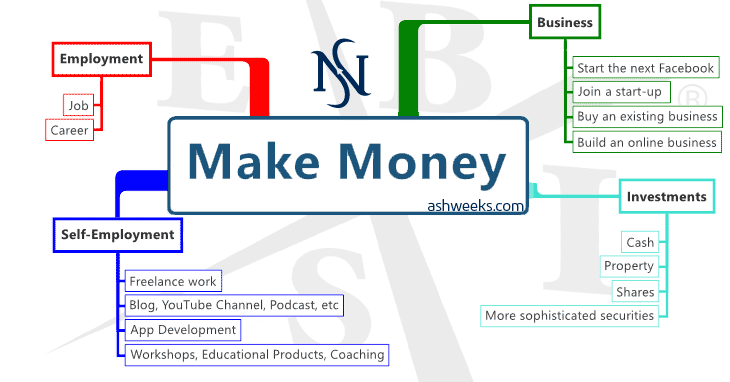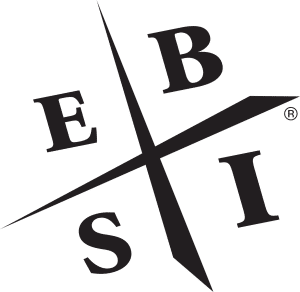This is part two of the different methods of making money. See part one for the introduction.
The image I put together for this post has the Cashflow Quadrant in it from Robert Kiyosaki’s Rich Dad Poor Dad series (including the Cashflow Quadrant book). Both books are a fantastic way to improve your financial literacy: Rich Dad Poor Dad is an introductory book on personal finance, and Cashflow Quadrant is a more advanced book that goes into more detail on the differences between the different quadrants. I recommend them to anyone who wants to begin the journey of wealth creation.
The Pros and Cons
Employment
You have a job. Employment covers anything that involves you trading your time for money, and the work is controlled by someone else.
Pros
- No business risk: whether the company that employs you is making a profit or not does not directly affect you
- No business skills required: you don’t need to know how a business runs, you just do your job and get paid for it
- Stable income: stable only in the sense that you know how much you are going to earn each week or month. Not year, however, as you may be made to leave your job
- Each hour worked produces direct income: if you work 10 hours, you’re paid for it. If you work 50 hours, you’re paid for it
- Regular hours: you are given set hours to work, plus or minus some extra hours. You can plan your week accordingly
- More social: depending on the job, you can socialise with people more
- Less initiative required: you mostly do what you’re told to do or what you’re good at, that’s it
Cons
- No long term stability: your continued position is reliant on factors such as the performance of the company you work for, the advancement of technology, how much your skills are in demand, and economic cycles
- Restricted growth in income
- Hourly rate: in a low-skill job, supply of labour is high and the hourly rate for the work stays relatively low besides usual increases with inflation; if you are in a higher-skill role, there is likely to be room for promotions, but the size and profitability of the company you work for can put a ceiling on your promotions; also, promotions tend to be infrequent so the speed at which you can increase you hourly rate is very low
- Hours: if you don’t trade your time for money, money stops coming in
- Less flexibility: of roles, of responsibilities, of time, of place — your work time and (usually) place are fixed and can rarely be moved to allow flexibility
- No tax advantages: usual income tax on everything you earn
- Less influence: if you aren’t happy with your role, the people you work with, or your pay, there’s not much you can usually do about it if management don’t help you
Self-Employment
You own a job. Self-Employment covers anything that involves you trading your time for money, and you work in your own business.
Pros
- More control: you control the direction your business goes in, the work that you do, how often you work, whether to hire employees — everything
- More flexibility: you work when you want to. You can start or finish early, have a day off, work extra hours one day. It’s up to you
- More potential to grow income: as your business grows it becomes more profitable. When your business is growing its income by 10% a month, you’re well ahead of the employees in their jobs
- Tax benefits: businesses get preferential tax treatment. For example (in general only — some exceptions apply):
- if you make more than A$80,000 (profit) before tax, you pay less tax if it was earned through business products or services than if you earned it as an employee;
- many expenses can be paid for with before-tax income, which is like getting a 20-50% discount on some purchases, depending on your tax bracket; and,
- tax is paid once every three months, instead of being taken from you before you see your income. This means you hold onto your cash for longer.
- Depending on the business, you might be able to eventually remove yourself from the business, turning Self-Employment income into Business income
Cons
- Business risk: if your business isn’t making money, you’re directly affected
- Business skills required: you need to know how a business runs
- Unstable income: you often make losses at the beginning, and income can fluctuate up or down once established
- Delayed benefits: you often need to put in lots of hours now for some future benefits
- Irregular hours: the business relies on you and if you don’t put in extra hours when it’s busy or struggling, your income is at risk
- Potentially less social: depending on the job, you might be working solo or with a couple of employees whom you may not be able to have a usual social relationship with
- More initiative required: if a problem is brought to your attention, it’s your responsibility to solve it. Being “off-the-clock” doesn’t mean anything in these situations, and there’s no one to turn to unless you have the right employee or consultant on call
- Hours: if you don’t trade your time for money, money stops coming in
Business
You own a business — a system of capital and people that makes money for you. Business income covers any income that comes from a business you don’t need to be there for in order for it to generate profit.
Pros
- More control: you control the direction your business goes in, how much to grow — any executive decisions you choose to have
- Even more potential to grow income: as your business grows it becomes more profitable. If your business is at the point that you don’t need to be there for it to run profitably, you’re in a position to put your time into the next business. You are also more likely to have access to large amounts of money, and be in a position to make investments and strategic decisions that bump up a, for example, $200,000 net profit up to $250,000 in a year. 25% increases in income at this point are massive in dollar terms
- Passive income: you don’t trade your time for money. Money comes in while you sleep
- Tax benefits: businesses get preferential tax treatment. For example (in general only — some exceptions apply):
- if you make more than A$80,000 (profit) before tax, you pay less tax if it was earned through business products or services than if you earned it as an employee;
- many expenses can be paid for with before-tax income, which is like getting a 20-50% discount on some purchases, depending on your tax bracket; and,
- tax is paid once every three months, instead of being taken from you before you see your income. This means you hold onto your cash for longer.
Cons
- Business risk: if your business isn’t making money, you’re directly affected. Problems or challenges that arise and knock 20% off your profits can reduce your income by, for example, $40,000 (using the example above of an original $200,000 p.a. profit)
- Business skills required: you need to know how a business runs, and you need to know (or hire someone who knows) more advanced knowledge of corporate finance, tax, and business strategy if your business grows large enough
- Not easy to achieve: you either buy straight into majority ownership of an existing business, which requires a lot of capital, or you build up your own business from self-employment levels to a large enough size that you can remove yourself from the business
Investments
Money making you more money.
Pros
- Passive income: you don’t trade your time for money. Money comes in while you sleep
- Exponential growth in income: this is money making more money. As the balance of your investments increase, the rate at which it increases will also speed up.
- Exercise:
- Go into Excel and use two columns, A and B. In the first cell of each column (A1 and B1), put in $1,000. In the second cell of the first column, type ‘=A1 + $100’, and in the second cell of the second column, type ‘=B1 x (1 + 10%)’. Now copy those formulas down to row 30.
- Imagine that each row is 1 year. At the end of the first year you have $1,000. Column A tells the story of what happens if your $1,000 investment gives you a 10% return on your money, and you take the money each year and hold it in cash (earning no interest). Column B tells the story of what happens if your $1,000 investment gives you a 10% return on your money, and that money is left in the investment (it’s reinvested).
- After Year 2, both scenarios are the same. But after Year 3, you start to see the difference: Column B has produced an additional $110 instead of the previous year’s $100. This is because the 10% return is now based on $1,100.
- A $10 difference might not seem like much after Year 3. Perhaps that’s part of the reason why people don’t invest — they don’t look far enough into the future, or they struggle to delay gratification. Because by the end of Year 10, if you didn’t reinvest your investment’s earnings, you’d have $1,900, versus the ~$2,350 if you had — about $450 or about 25% higher. By Year 20, the difference is about $3,200 or ~110%. By Year 30 it’s about $12,000 or over 300%.
- When you consider your future, consider how many years your money has to increase. If you’re 15-30 years old right now, then you easily have 30 years until traditional retirement age. When you’re older you’re going to have wanted your younger self to have started investing early. A 300% difference on $500,000 in lifetime savings, for example, is $1.5 million.
- Exercise:
- Tax benefits. For example:
- you can set up a company that invests on your behalf, which would receive the same tax benefits as businesses;
- you can set up a trust entity that invests on your behalf, which can distribute taxable income to the people in your family with the lowest personal incomes first, effectively paying a lower tax rate than you would if the investments were through you personally;
- you can invest through superannuation funds which have tax benefits over individuals;
- some losses made on investments made personally can directly reduce your personal income tax; and,
- tax on capital gains can be deferred until the time of sale, which can be for as many years as you hold onto it for. Additionally, capital investments that are held for longer than 12 months get a 50% discount on the amount of profit that is taxed.
Cons
- Investment risk: unless your money is sitting in an interest-bearing account, there is likely to be risk associated with your investment. There is a chance that you could lose money. Increasing your financial literacy can reduce this risk to a more manageable level
- Slow beginning: you can’t get wealthy by only sitting your money in a fund that returns 7% p.a. on average if you begin at $1,000. Exponential returns start slow and increase in speed as time goes by
- Investment knowledge required: sticking money into a fund or a bunch of “blue chip” shares requires some basic understanding of financial and capital markets. However, creating significant wealth through investing requires a much greater understanding of banking, tax, your chosen investment/s, and financial planning
Choosing Your Next Actions
So what is the best strategy for you, given your ideal lifestyle, willingness to take on responsibility and risk, and how quickly you want to achieve your goals?
Knowing what you want (lifestyle), and armed with the options you have to achieve it (the list of types of money making methods in the previous post, and the pros and cons above), you are in a position to make a good decision about what to do next.
Your strategy can (and should) include income from more than one quadrant (employment, self-employment, business, investment). Everyone should have some savings which might begin in a high-interest online savings account, which could grow to a size large enough to be put into some shares (investment income).
This savings can be generated from employment income at the beginning. As time goes on you could start your own business on the side part-time, growing it to the point where you can leave your job and work on your business full-time. Ideally, your business can grow to the point where it is bringing in profit while you replace yourself with employees. Your business is now generating passive income and you can either live off that and invest the rest to increase your wealth over time, or you can work on your next business!
If your business is successful enough, you could take your company public or sell it to a giant like Google or Facebook. That’s where the big money is made.
The strategy you go with is your choice. It is a significant one that shouldn’t be taken too lightly — if you’re willing to put in the effort, and take on the responsibility and risk, you can achieve wealth goals in something like 10 years instead of the traditional 40 years in a job. If you’re like me, you would rather work your arse off for those 10 years in work that you’re passionate about in order to become financially free, than work in a job for 40 years to become financially free. There’s more to life than sacrificing 40 years to work.
Note: The tax rules mentioned in this post are relevant only in Australia.







